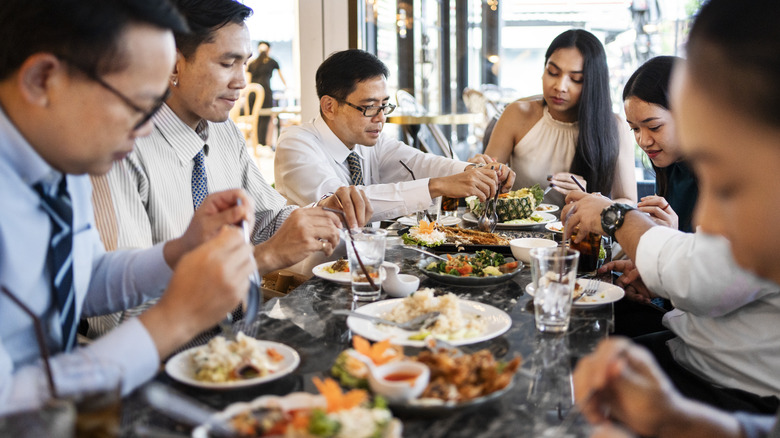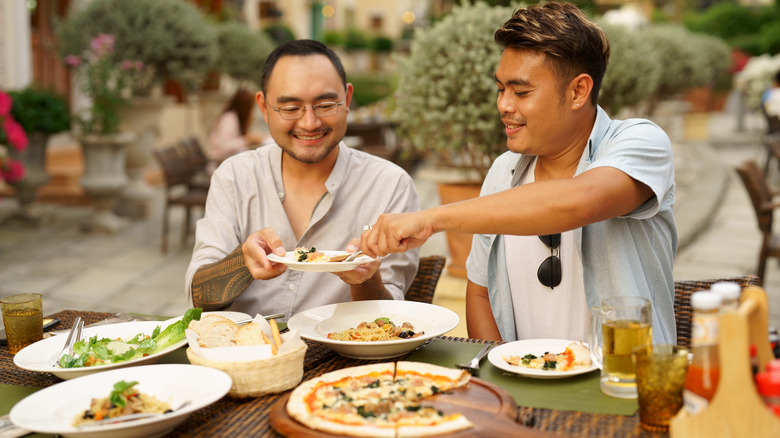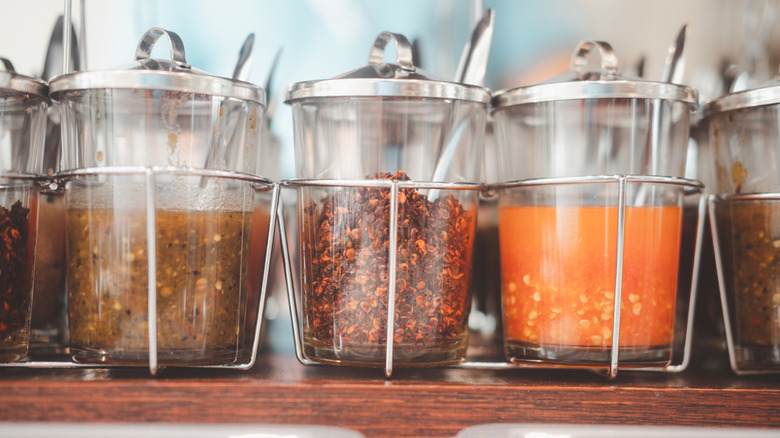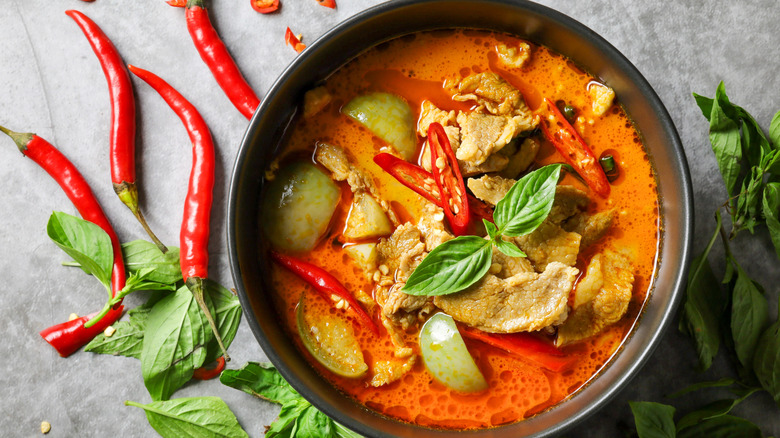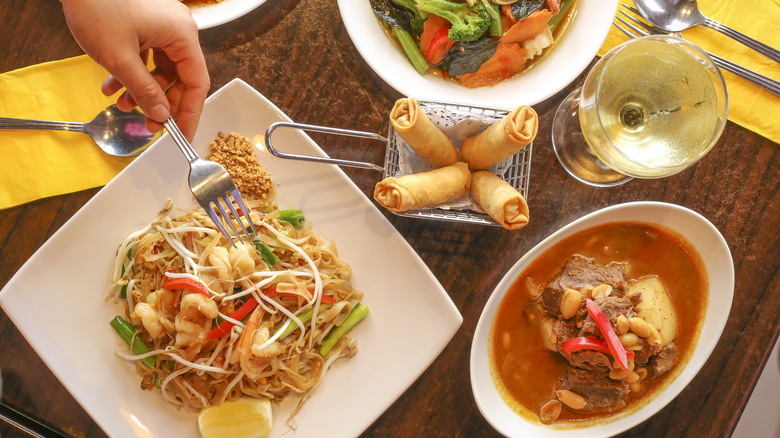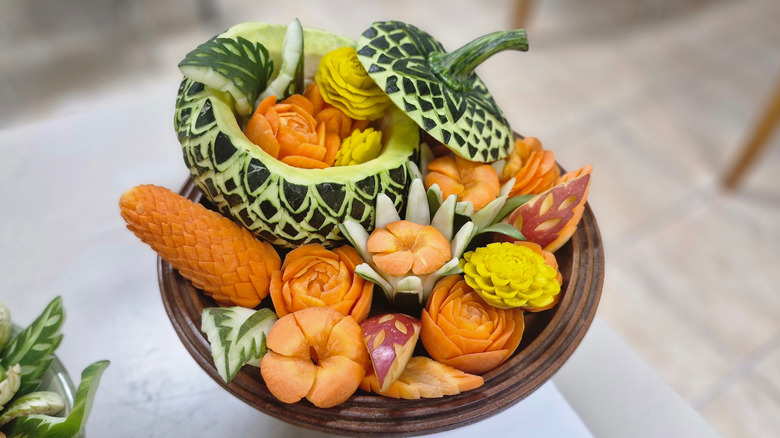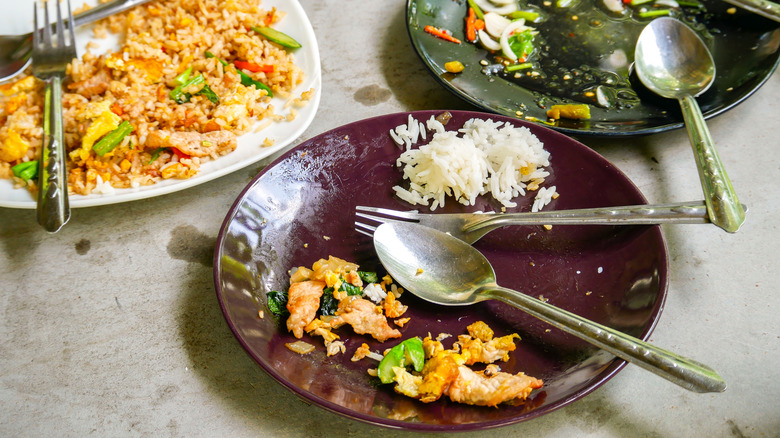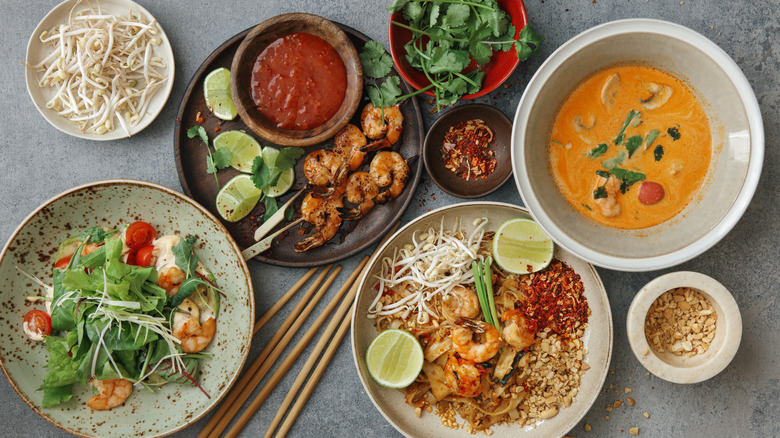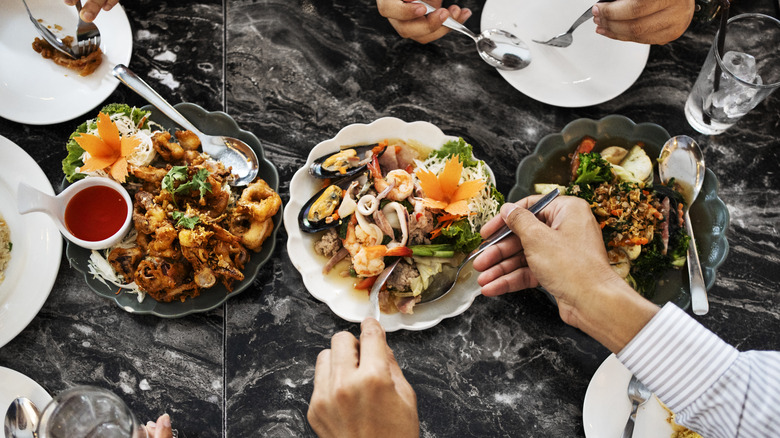Avoid These Mistakes When Dining At A Thai Restaurant
Walking unprepared into a Thai restaurant, whether in the U.S. or Thailand, can be a bit overwhelming if you don't know what to order or the traditional way a meal is expected to be enjoyed. With a menu filled with unfamiliar dishes and the very real fear that the spice levels might take you by surprise, you might hesitate to ask questions or worry about ordering something you can't handle. Part of this comes down to a lack of familiarity with the different regional styles of Thai cuisine.
Acquainting yourself with the basics of Thai food means understanding regional influences and the seasonings used to achieve the signature balance of flavors and textures. Knowing about dining etiquette is equally important, as Thais eat in a very different manner from Americans. Being mindful of these distinctions is a small but meaningful way to honor the culture you are about to experience. A little knowledge of the cuisine and awareness of some common missteps can help you order the kinds of dishes that will turn an ordinary dinner into a memorable one.
Not trying something new
The variety of foods on offer at a Thai restaurant can be truly impressive, with something available to suit every palate. This can make choosing from a menu a truly bewildering experience, especially for newcomers. The Thai names can add to the confusion, and many diners may fall into the comfortable trap of selecting the same old dish over and over again. Not to say that ordering your favorite dishes is a bad thing, but the downside is that you might miss out on discovering a dish that could become your new favorite. It's time to stop hiding behind the "Thai food = pad Thai or pineapple fried rice" mentality and try a dish that is outside your comfort zone instead.
You could start with a Thai salad (or yam), which, unlike a Western salad, is an interesting combination of sweet, sour, salty, and spicy flavors. Thai soups are a whole different ballgame as well, packed with rich aromas and flavors — Tom Yum Goong (spicy shrimp soup) is a prime example. Meanwhile, spice lovers may fall in love with red curry, a spicier alternative to its milder green counterpart. The list is endless as Thai cuisine is truly a universe of flavors just waiting to be explored. If you're unsure what to order, don't hesitate to ask your server for help; they'll often be happy to guide you through the menu.
Using the wrong utensils
One common mistake that many people make at Thai restaurants is eating rice with chopsticks. In Thailand, chopsticks are used only for noodles, while rice is eaten with a fork and spoon. This is simply the most efficient way to enjoy rice, which is often served with plenty of gravy and sauces.
There is also a right and a wrong way to use the cutlery. According to Thai custom, you eat rice with a spoon and use the back of the fork to gently push rice onto it. The fork is only used to eat foods that aren't served with rice, and knives are rarely needed, as most Thai dishes come bite-sized. Thai soups are a bit different. A noodle soup such as Khao Soi is usually served with chopsticks and a soup spoon. This is the traditional way to enjoy these dishes in Thailand. Eating rice and other foods in this manner, even if you're dining at a Thai restaurant in the U.S., is a polite way to show respect for the culture.
This is not to say that all Thai restaurants in the U.S. will follow this system. Some traditional ones will, while others may have adopted American ways and will probably place chopsticks at every table. If you see a Thai restaurant setting with just a spoon and fork next to the plate, consider it a good indication that the food is authentic.
Not being curious about the condiments
Many times, the condiments added to a dish transform it to the next level of deliciousness. This is especially true in the case of Thai foods. Condiments play an integral role, either enhancing or sometimes altogether changing the flavor of a dish, so understanding a bit more about how these magical additions work is highly recommended.
Many Thai restaurants have a small basket with several condiments on every table. These various add-ons typically cover the different flavor groups. They often include chili flakes or pastes to add spice, chili-garlic infused vinegar for a touch of sourness, sugar for sweetness, and fish sauce for saltiness. Adding a little (or a lot) of any or all of these condiments can balance out the flavor profile of any meal or customize it to your palate — what's not to love about that?
You may also come across a bunch of different sauces known as nam prik, made from a range of local and traditional ingredients, like chilis and fermented shrimp paste. Even if you don't know all the ingredients, try a little out and see how it goes. At best, you may find a new must-have condiment. Just use nam prik judiciously, trying a bit first to check aromas, flavors, and spice levels, before proceeding with aplomb.
Not asking about the spice levels
For those in the know, Thai cuisine can be pretty spicy, so not asking about the spice levels of your Thai dishes before ordering can be a recipe for disaster. You might end up unable to eat at all, or suffer an uncomfortable burning mouth or stomach. Spice encounters of the worst kind happen quite often at Thai restaurants, so it pays to take precautions.
Some restaurants in the U.S. may tone down the spice to suit local tastes or ask you to specify your preferred spice level. Note, however, that what most Thais consider mild may still be spicy for you. Usually, a Thai restaurant indicates the spice level on the menu, and your server will check what levels you are comfortable with to tailor your order.
Even if you can handle spice, be careful when ordering anything on the menu described as spicy, as you may be biting off more than you can chew. But if you can deal with it, then go ahead and be prepared for a fantastic, flavorful ride. Phrases like "mai phet" or "no spice" can help indicate your preference if your server is Thai. If you find your food too spicy, wash it down with some Thai beer, which may be served with ice, a pleasantly refreshing touch.
Not checking about allergens
If you suffer from allergies, then you really need to be careful at a Thai restaurant and inform yourself about all the ingredients used before placing your order. One common culprit is soy sauce, which usually contains gluten (unlike tamari, which is not often used in Thai restaurants). Most varieties contain wheat, so be sure to specify no soy sauce while ordering.
Another commonly used allergen in Thai cooking is peanuts, which can show up whole or as peanut sauce. Seafood intolerance is another common allergy, and since shrimp paste and fish sauce are regularly used, make sure to mention your allergy to your server. Although most Thai dishes do not use dairy products, it is wise to be cautious. Thai cuisine is diverse enough to offer plenty of delicious, allergy-safe options. Failing to disclose your allergies could lead to serious health issues and spoil what would otherwise be a wonderful dining experience.
Stressing about vegetarian options
We get it — trying a new cuisine can be overwhelming, especially when navigating a menu with any type of dietary restrictions. Fortunately, eating at a Thai restaurant if you are a vegetarian is not as challenging as you might think. Many dishes lend themselves to customization, so don't be afraid to ask. For example, pad Thai can often be made with tofu and vegetables instead of meat. Thai curries can include mushrooms and eggplant, and you likely won't even miss the chicken or beef. The phrase "mang sa wirat" means no meat, so show off your language skills when ordering and gain some brownie points in the process.
A key reason Thai food is so flavorful is because of the expert use of condiments. However, many of these, like fish sauce, oyster sauce, or shrimp paste, which are the staples of any Thai recipe, are not vegetarian or vegan. If you have strict dietary restrictions, it would be better to ask ahead whether these condiments are in the dish and change your order accordingly. Keep in mind that it is not as simple as just leaving them out, as they are often required for the piquant balance of flavors so beloved in Thai food. Finally, don't hold back when it comes to sweets. Thai desserts are usually coconut milk-based or incorporate some form of fresh fruit, so they're all naturally vegetarian and delicious.
Not appreciating the presentation
In traditional Thai culture, the presentation of food is as important as the taste and flavor. Chefs are trained in vegetable and fruit carving to add layers and visual appeal to every dish, no matter how small. Herbs and vegetables are used to instill a vibrant brightness to a dish. If you are a regular at Thai restaurants, you may have noticed how slices of bright peppers enhance a green curry or the way edible flowers and herbs decorate a stir-fry platter. These are not just for the aesthetics, though. They also indicate the flavors of the food that's prepared.
Depending on the area of Thailand your dish comes from, the presentation style will differ. For example, food from Northern Thailand often comes wrapped in banana leaves or served on large sharing platters. Southern Thai food involves a lot more decorative elements and intricate details that add to the overall wow factor of your meal. Garnishes such as carrots carved to look like flowers or spirals of cucumber add beauty to even a simple dish. When dining at a Thai restaurant, it would serve you well to appreciate these finer details for the skill and patience they require, instead of tossing them aside as useless. And yes, you can eat them as well. In fact, layering textures and tastes is what makes each bite of a Thai dish so harmonious and satisfying.
Overloading your plate in one go
If you're eating at a restaurant in Thailand or at a Thai friend's home, these etiquette rules are even more important. That said, even if you are just heading out for dinner at a local Thai restaurant, it doesn't hurt to be more culturally aware of the meal you are about to enjoy. Thai dining (like much of the culture) is laden with meaning and significance. What you eat, the order in which you eat, and how much you eat are all influenced by years of social and historical influences.
Unlike Western dining traditions, where each course is served together, Thai restaurants often serve dishes in succession for the table to share. For this reason, it's recommended that you don't fill up on one dish alone, and instead, scoop a couple of small spoonfuls onto your plate so you can try everything. Helping yourself to too much of one dish also prevents others at your table from enjoying their portion. This is not an all-you-can-eat buffet experience. Portions are typically smaller and can be replenished if necessary. Piling up your plate precariously will only cause consternation among more traditional diners.
Wasting food (especially rice)
Apart from the fact that Thailand is one of the world's major rice producers,the grain also plays an important role in social and religious traditions. Rice is offered to the spirits, gifted to the monks, and revered as a nutritious staple meant for all to enjoy.
At a traditional Thai restaurant, rice will usually be served in a large bowl. This is not de rigueur, but if you want to stick to tradition, you should never serve yourself only one spoonful of rice – have at least two or three. This is because one spoon of rice is usually only served as a symbolic offering to the dead. Rice pairs perfectly with any Thai dish, from zingy raw papaya salads to rich coconut curries. It's the ideal accompaniment, balancing all the intense flavors and spices.
Faced with a table laden with several dishes, you may be tempted to serve yourself more than you end up eating. But whatever you do, try not to waste any food. Waste is frowned upon, especially when it comes to rice. It's better to serve yourself less and go back for more (no shame in that) than to overfill your plate and leave food behind. Leaving rice uneaten is considered disrespectful to your host and best avoided.
Ordering only one main course
With most restaurant meals in the U.S., you sit down, have a look at the menu, and order a few appetizers and individual entrees or mains. That's not how it works at a Thai restaurant, though. To maximize your enjoyment, think like a Thai and expand your repertoire (and your belt while you're at it) because you are in for a feast. Thai meals can start with soup (the only item that is individually served) and then move on to a huge variety of mains and appetizers, all ordered at the same time.
Ideally, there should be salads on your table (be aware that salads in Thailand may also include meat), fried snacks, rice, noodles, curries, and stir-fries. There may even be some form of grilled meat or seafood to add to the lineup. Even if you are dining alone, get out of your comfort zone and order a few mains to try. Portions are rarely too large, and if you can't finish it all, there's always takeaway. Eating at a Thai restaurant in a group can be the most fun because you get to try several different dishes at once. The idea behind this array of food is the principle of Thai cooking – balancing sweet, salty, spicy, and sour flavors for a complete and fully satisfying meal. Don't do yourself the disservice of sticking to only one main.
Eating without waiting for the proper cues
If you want an authentic Thai experience or you're dining at a traditional Thai restaurant, it helps to be aware of the cultural dos and don'ts in advance. This will go a long way toward endearing yourself to your Thai hosts and enhancing your overall culinary experience. Thai hospitality is legendary, but with it comes a long list of what is and is not acceptable. Most of this is rooted in religion and tradition, so brushing up on these notions will only help matters.
Some easy cues to remember include waiting for the eldest at the table to start eating first, serving others before yourself, leaving food for others to enjoy, and not touching anyone on the head or pointing your feet at them. Don't blow your nose at the table or make slurping sounds (yes, we know it's different in Japan, but things change in different parts of the world). Other rules include trying everything that's served to you (even just a small bite), not using your left hand to eat (even if you're left-handed), and avoiding food waste.
The easiest way to read cues is to observe what others are doing and follow suit. That way, you won't barrel in and make a fool of yourself, enjoying your meal with all its complex layers — both in terms of the food and the customs.
